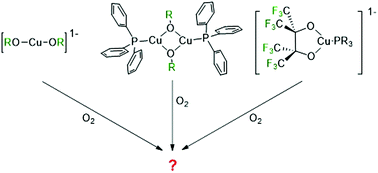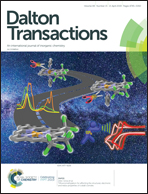Cu(i)–O2 oxidation reactions in a fluorinated all-O-donor ligand environment
Abstract
Investigation of Cu–O2 oxidation reactivity is important in biological and anthropogenic chemistry. Zeolites are one of the most promising Cu/O based oxidation catalysts for development of industrial-scale CH4 to CH3OH conversion. Their oxidation mechanisms are not well understood, however, highlighting the importance of the investigation of molecular Cu(I)–O2 reactivity with O-donor complexes. Herein, we give an overview of the synthesis, structural properties, and O2 reactivity of three different series of O-donor fluorinated Cu(I) alkoxides: K[Cu(OR)2], [(Ph3P)Cu(μ-OR)2Cu(PPh3)], and K[(R3P)Cu(pinF)], in which OR = fluorinated monodentate alkoxide ligands and pinF = perfluoropinacolate. This breadth allowed for the exploration of the influence of the denticity of the ligand, coordination number, the presence of phosphine, and K⋯F/O interactions on their O2 reactivity. K⋯F/O interactions were required to activate O2 in the monodentate-ligand-only family, whereas these connections did not affect O2 activation in the bidentate complexes, potentially due to the presence of phosphine. Both families formed trisanionic, trinuclear cores of the form {Cu3(μ3-O)2}3−. Intramolecular and intermolecular substrate oxidation were also explored and found to be influenced by the fluorinated ligand. Namely, {Cu3(μ3-O)2}3− from K[Cu(OR)2] could perform both monooxygenase reactivity and oxidase catalysis, whereas those from K[(R3P)Cu(pinF)] could only perform oxidase catalysis.

- This article is part of the themed collections: Challenges in organometallic & coordination chemistry: in celebration of Geoff Cloke’s 65th birthday and 2019 Frontier and Perspective articles


 Please wait while we load your content...
Please wait while we load your content...
